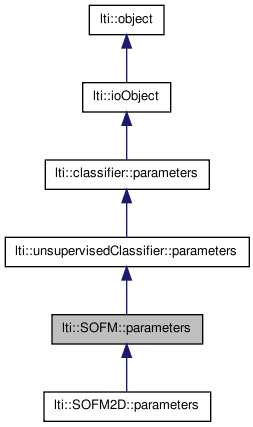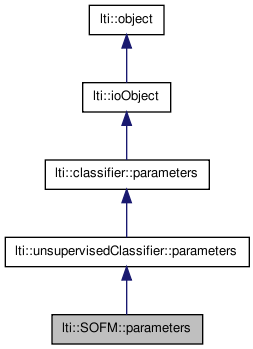

|
latest version v1.9 - last update 10 Apr 2010 |
|
the parameters for the class SOFM More...
#include <ltiSOFM.h>


Public Types | |
| enum | eInit { Random = 1, Linear = 2 } |
| enum | eMetric { L1 = 1, L2, Dot } |
Public Member Functions | |
| parameters () | |
| parameters (const parameters &other) | |
| virtual | ~parameters () |
| const char * | getTypeName () const |
| parameters & | copy (const parameters &other) |
| parameters & | operator= (const parameters &other) |
| virtual classifier::parameters * | clone () const |
| virtual bool | write (ioHandler &handler, const bool complete=true) const |
| virtual bool | read (ioHandler &handler, const bool complete=true) |
Public Attributes | |
| eInit | initType |
| eMetric | metricType |
| int | stepsOrdering |
| double | orderLearnMax |
| double | orderLearnMin |
| double | orderNeighborMax |
| double | orderNeighborMin |
| double | orderNeighborThresh |
| int | stepsConvergence |
| double | convergenceLearnMax |
| double | convergenceLearnMin |
the parameters for the class SOFM
Possible types of initialization for the grid of neurons:.
Different metrics can be used to determine the distance between an input vector and each neuron.
| lti::SOFM::parameters::parameters | ( | ) |
default constructor
Reimplemented from lti::unsupervisedClassifier::parameters.
Reimplemented in lti::SOFM2D::parameters.
| lti::SOFM::parameters::parameters | ( | const parameters & | other | ) |
copy constructor
| other | the parameters object to be copied |
Reimplemented from lti::unsupervisedClassifier::parameters.
Reimplemented in lti::SOFM2D::parameters.
| virtual lti::SOFM::parameters::~parameters | ( | ) | [virtual] |
destructor
Reimplemented from lti::unsupervisedClassifier::parameters.
Reimplemented in lti::SOFM2D::parameters.
| virtual classifier::parameters* lti::SOFM::parameters::clone | ( | ) | const [virtual] |
returns a pointer to a clone of the parameters
Reimplemented from lti::classifier::parameters.
Reimplemented in lti::SOFM2D::parameters.
| parameters& lti::SOFM::parameters::copy | ( | const parameters & | other | ) |
copy the contents of a parameters object
| other | the parameters object to be copied |
Reimplemented from lti::unsupervisedClassifier::parameters.
Reimplemented in lti::SOFM2D::parameters.
| const char* lti::SOFM::parameters::getTypeName | ( | ) | const [virtual] |
returns name of this type
Reimplemented from lti::unsupervisedClassifier::parameters.
Reimplemented in lti::SOFM2D::parameters.
| parameters& lti::SOFM::parameters::operator= | ( | const parameters & | other | ) |
copy the contents of a parameters object
| other | the parameters object to be copied |
Reimplemented from lti::unsupervisedClassifier::parameters.
Reimplemented in lti::SOFM2D::parameters.
| virtual bool lti::SOFM::parameters::read | ( | ioHandler & | handler, | |
| const bool | complete = true | |||
| ) | [virtual] |
read the parameters from the given ioHandler
| handler | the ioHandler to be used | |
| complete | if true (the default) the enclosing begin/end will be also written, otherwise only the data block will be written. |
Reimplemented from lti::classifier::parameters.
Reimplemented in lti::SOFM2D::parameters.
| virtual bool lti::SOFM::parameters::write | ( | ioHandler & | handler, | |
| const bool | complete = true | |||
| ) | const [virtual] |
write the parameters in the given ioHandler
| handler | the ioHandler to be used | |
| complete | if true (the default) the enclosing begin/end will be also written, otherwise only the data block will be written. |
Reimplemented from lti::classifier::parameters.
Reimplemented in lti::SOFM2D::parameters.
Maximum value of learn-rate during convergence.
Minimum value of learn-rate during convergence.
type of initialization method used.
See eInit.
type of metric used.
See eMetric.
Maximum value of learn-rate during ordering.
Minimum value of learn-rate during ordering.
Maximum distance to the winner neuron during ordering.
The unit is in grid steps. E.g. a value of 1 would include (theoretically) the 8 neighbors, since a square window is assumed. You can change this by setting orderNeighborThresh to an appropriate value.
Minimum distance to the winner neuron during ordering.
The neighborhood stays like this for the convergence phase. This value should be rather low, typically 1. For values below 1 no neighborhood is created which will not work!
The minimum value the neighborhood function assumes (cut-off value).
This should be rather low. Since a Gaussian kernel is used this value steers the size of the kernel to be used. I.e. the bigger the value, the faster the training and the less precise. E.g. if for the current neighborhood size the Gaussian value is smaller than the threshold for the roof of the neighborhood value, the kernel size will be lower than the roof of the neighborhood size.
Number of epochs used for convergence in the training.
Number of epochs used for ordering in the training.